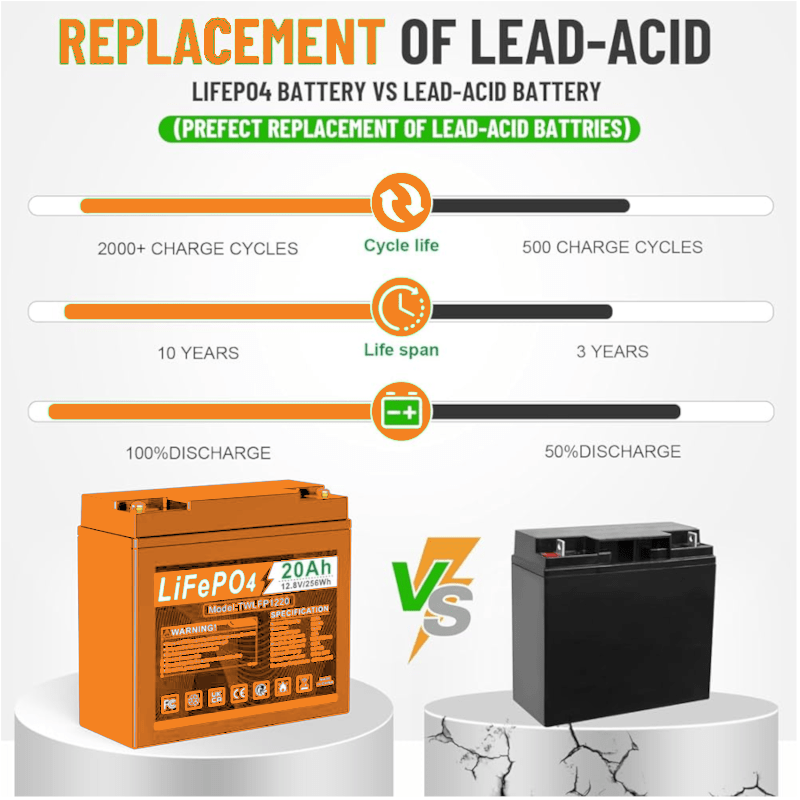Lifepo4 (Lithium) vs Lead-Acid
If you are looking for a reliable and efficient energy storage solution you might be wondering whether to choose lifepo4 or lead-acid batteries. Both types of batteries have their advantages and disadvantages, depending on your needs and preferences. In this article, we will compare lithium and lead-acid batteries in terms of performance, durability, cost, and environmental impact, to help you make an informed decision.
Performance
One of the most important factors to consider when choosing a battery is its performance, which includes its capacity, power, efficiency, and lifespan.
Capacity
The capacity of a battery is the amount of energy it can store and deliver. It is measured in amp-hours (Ah) or watt-hours (Wh). The higher the capacity, the longer the battery can run your appliances and devices.
Lithium batteries have a higher capacity than lead-acid batteries of the same size and weight. For example, a 100Ah lithium battery can provide 100Ah of usable energy, while a 100Ah lead-acid battery can only provide 50Ah of usable energy at best. This is because lithium batteries can be discharged up to 100% depth of discharge (DoD), while lead-acid batteries should not be discharged below 50% DoD to avoid damaging the cells.
Power
The power of a battery is the rate at which it can deliver energy. It is measured in watts (W) or amps (A). The higher the power, the faster the battery can charge and discharge, and the more appliances and devices it can run simultaneously.
Lithium batteries have a higher power than lead-acid batteries of the same capacity. For example, a 100Ah lithium battery can deliver up to 200A of continuous current, while a 100Ah lead-acid battery can only deliver up to 100A of continuous current. This is because lithium batteries have a lower internal resistance than lead-acid batteries, which means they can handle higher currents without overheating or losing efficiency.
Efficiency
The efficiency of a battery is the ratio of the energy output to the energy input. It is expressed as a percentage (%). The higher the efficiency, the less energy is wasted during charging and discharging.
Lithium batteries have a higher efficiency than lead-acid batteries. For example, a lithium battery can have an efficiency of up to 98%, while a lead-acid battery can have an efficiency of around 80%. This means that lithium batteries can store and deliver more energy from the same amount of solar input or generator output than lead-acid batteries.
Lifespan
The lifespan of a battery is the number of charge and discharge cycles it can undergo before its capacity drops below 80% of its original value. The higher the lifespan, the longer the battery can serve you before needing replacement.
Lithium batteries have a longer lifespan than lead-acid batteries. For example, a lithium battery can last up to 2000 cycles at 100% DoD, while a lead-acid battery can last up to 600 cycles at 50% DoD. This means that lithium batteries can endure more frequent and deeper cycling than lead-acid batteries without losing much capacity.
Durability
Another factor to consider when choosing a battery is its durability, which includes its resistance to temperature, vibration, and corrosion.
Temperature
The temperature of the environment where the battery is installed and operated can affect its performance and lifespan. Extreme temperatures can cause thermal stress, expansion, contraction, and chemical reactions that can damage the cells.
Lithium batteries are more resistant to temperature than lead-acid batteries. For example, lithium batteries can operate in a wider temperature range than lead-acid batteries, from -20°C to +60°C. They also have built-in battery management systems (BMS) that monitor and regulate the temperature of each cell to prevent overheating or freezing. Lead-acid batteries are more sensitive to temperature changes and require more ventilation and insulation to maintain optimal performance.
Vibration
The vibration of the vehicle or vessel where the battery is installed and operated can also affect its performance and lifespan. Excessive vibration can cause physical damage, loose connections, and internal short circuits that can reduce the capacity and power of the battery.
Lithium batteries are more resistant to vibration than lead-acid batteries. For example, lithium batteries are made of solid-state cells that are tightly packed and sealed in sturdy cases that prevent movement and leakage. They also have BMS that protect them from short circuits and overloads. Lead-acid batteries are made of liquid electrolyte and plates that are prone to spilling and sulfation under vibration.
Corrosion
The corrosion of the terminals and connectors of the battery can also affect its performance and lifespan. Corrosion can cause increased resistance, reduced conductivity, and poor contact that can reduce the capacity and power of the battery.
Lithium batteries are more resistant to corrosion than lead-acid batteries. For example, lithium batteries have stainless steel or brass terminals and connectors that are less likely to rust or oxidize than lead-acid batteries. They also have BMS that prevent overcharging and undercharging that can cause corrosion.
Cost
The cost of a battery is another factor to consider when choosing a battery. It includes the initial purchase price, the installation cost, the maintenance cost, and the replacement cost. But in 2024, its usually far cheaper per cycle to purchase a Lifepo4 battery. Usually 5-10 times cheaper or more.
Purchase Price
The purchase price of a battery is the amount of money you pay upfront to buy the battery. It is usually based on the capacity, power, and quality of the battery.
Lithium batteries have a higher purchase price than lead-acid batteries of the same capacity and power. For example, a 100Ah lithium battery can cost around $400-$600, while a 100Ah lead-acid battery can cost around $300-$600. This is because lithium batteries use more advanced and expensive materials and technologies than lead-acid batteries, but recently the competition of Lithium Iron Lifepo4 has lead to very similar prices
Installation Cost
The installation cost of a battery is the amount of money you pay to install the battery in your vehicle or vessel. It is usually based on the size, weight, and complexity of the battery.
Lithium batteries have a lower installation cost than lead-acid batteries of the same capacity and power. For example, a 100Ah lithium battery can weigh around 12kg and take up around 20L of space, while a 100Ah lead-acid battery can weigh around 30kg and take up around 40L of space. This means that lithium batteries are easier and cheaper to install than lead-acid batteries, especially in tight and limited spaces.
Maintenance Cost
The maintenance cost of a battery is the amount of money you pay to maintain the performance and lifespan of the battery. It is usually based on the frequency, complexity, and necessity of the maintenance tasks.
Lithium batteries have a lower maintenance cost than lead-acid batteries. For example, lithium batteries are maintenance-free and do not require any watering, equalizing, or cleaning. They also have BMS that monitor and regulate their performance and health. Lead-acid batteries require regular maintenance such as watering, equalizing, cleaning, and checking for corrosion and sulfation. They also need external regulators to prevent overcharging and undercharging.
Replacement Cost
The replacement cost of a battery is the amount of money you pay to replace the battery when it reaches the end of its lifespan. It is usually based on the lifespan, availability, and recyclability of the battery.
Lithium batteries have a lower replacement cost than lead-acid batteries. For example, lithium batteries can last up to four times longer than lead-acid batteries, which means they need to be replaced less often. They are also more widely available and recyclable than lead-acid batteries, which means they are easier and cheaper to dispose of.
Environmental Impact
The environmental impact of a battery is another factor to consider when choosing a battery. It includes the energy consumption, greenhouse gas emissions, waste generation, and resource depletion associated with the production, use, and disposal of the battery.
Energy Consumption
The energy consumption of a battery is the amount of energy required to produce, charge, and discharge the battery. It is usually based on the efficiency, lifespan, and capacity of the battery.
Lithium batteries have a lower energy consumption than lead-acid batteries. For example, lithium batteries can store and deliver more energy from the same amount of solar or generator input than lead-acid batteries due to their higher efficiency. They also need less energy to produce due to their longer lifespan and smaller size.
Greenhouse Gas Emissions
The greenhouse gas emissions of a battery are the amount of carbon dioxide (CO2) and other gases released into the atmosphere as a result of the production, use, and disposal of the battery. They are usually based on the energy consumption, energy source, and recycling rate of the battery.
Lithium batteries have lower greenhouse gas emissions than lead-acid batteries. For example, lithium batteries can reduce CO2 emissions by up to 50% compared to lead-acid batteries due to their lower energy consumption and higher recycling rate. They also use renewable energy sources such as solar or wind more efficiently than lead-acid batteries due to their higher efficiency.
The production and carbon costs of Lead Acid vs Lithium, are very hard to know, with some saying Lithium is much worse, and it’s true that mining lithium and Iron and the other metals required may have a higher carbon footprint, but if you are using the battery daily, these will eventually become less.
Cranking Amps compared
When comparing cranking amps between LiFePO4 (Lithium Iron Phosphate) and lead-acid batteries, there are some important distinctions:
- LiFePO4 Batteries:
- LiFePO4 batteries are more effective at delivering a large amount of current over a short period.
- They are particularly suitable for applications where high cranking power is needed, such as starting engines or powering devices with significant initial current demands.
- For instance, if you require a battery that can sustain a 40-amp device for two hours straight, LiFePO4 is an excellent choice
- Lead-Acid Batteries:
- Lead-acid batteries have been around for a long time and are commonly used in various applications.
- While they have their advantages, such as being cost-effective, they are not as efficient as LiFePO4 batteries in terms of cranking amps.
- Lead-acid batteries may struggle to deliver high current consistently over a short duration compared to LiFePO4 batteries.
In summary, if you prioritize high cranking power and need a battery that can handle substantial current demands, LiFePO4 is the way to go.

